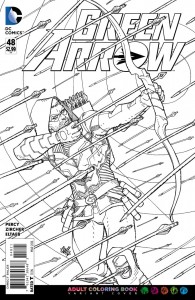 Before we get to the reviews, let’s give a shout-out to DC this week: their new batch of alternative covers for their January issues involves a cool coloring-book-ready black-and-white style, perfect for both kids and adults to pick up some markers and try their hands at the profession of cartoon colorist; even if you’re the kind of fan who shudders at ruining a perfectly-collectable comic, you can
Before we get to the reviews, let’s give a shout-out to DC this week: their new batch of alternative covers for their January issues involves a cool coloring-book-ready black-and-white style, perfect for both kids and adults to pick up some markers and try their hands at the profession of cartoon colorist; even if you’re the kind of fan who shudders at ruining a perfectly-collectable comic, you can  always remove the special thicker-paper outer cover, because the book’s regular one is right underneath it — or, buy two copies, one to color and one to keep (then, encourage everyone else to color their own copies, and you’ll have the only unmarked one left, and can charge a ton for it. Mwuhahahahahahhhh…). The four
always remove the special thicker-paper outer cover, because the book’s regular one is right underneath it — or, buy two copies, one to color and one to keep (then, encourage everyone else to color their own copies, and you’ll have the only unmarked one left, and can charge a ton for it. Mwuhahahahahahhhh…). The four  books featured this week are Action, Detective, Green Arrow and Green Lantern; the Green Arrow cover by Cully Hamner is the easiest and most elegant, while Scott Kolins, whose kind-of-blocky style is suited for this kind of thing, supplies the Action cover. That leaves the two best: the Detective cover by Timothy Green, whose only flaw is that it’s
books featured this week are Action, Detective, Green Arrow and Green Lantern; the Green Arrow cover by Cully Hamner is the easiest and most elegant, while Scott Kolins, whose kind-of-blocky style is suited for this kind of thing, supplies the Action cover. That leaves the two best: the Detective cover by Timothy Green, whose only flaw is that it’s 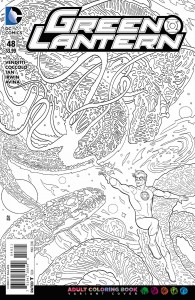 probably too detailed, and cries out to be larger-sized (and colored with florescent pencils, and shown under a black light, like one of those ’70s Marvel posters), and the Michael Allred Green Lantern cover, with GL battling cosmic dragons in space, which strikes the perfect balance between bold design and obsessive detail, and ought to have any potential comic-book colorists itching to grab their tools. Can’t wait to see what new versions might show up next week (and, as always, click on each image here to see a larger, more impressive version…).
probably too detailed, and cries out to be larger-sized (and colored with florescent pencils, and shown under a black light, like one of those ’70s Marvel posters), and the Michael Allred Green Lantern cover, with GL battling cosmic dragons in space, which strikes the perfect balance between bold design and obsessive detail, and ought to have any potential comic-book colorists itching to grab their tools. Can’t wait to see what new versions might show up next week (and, as always, click on each image here to see a larger, more impressive version…).
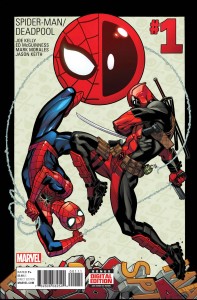 Spider-Man/Deadpool #1 — Writer: Joe Kelly; Pencils: Ed McGuinness; Inks: Mark Morales; Colors: Jason Keith
Spider-Man/Deadpool #1 — Writer: Joe Kelly; Pencils: Ed McGuinness; Inks: Mark Morales; Colors: Jason Keith
Deadpool #5 — Writer: Gerry Duggan; Pencils: Mike Hawthorne; Inks: Terry Pallot; Colors: Guru-eFX
True Believers: Deadpool #1 (Reprinting New Mutants #98 — Writer: Fabian Nicieza; Plot/Art: Rob Liefeld; Colors: S. Buccellato)
It’s Wade Wilson’s world right now, with a movie on the way and full-size blowups of the “merc with a mouth” already in movie theaters everywhere, and Marvel’s capitalizing on it, with three new Deadpool comics this week. Spider-Man/Deadpool is a natural match: both characters are quick with a quip, but 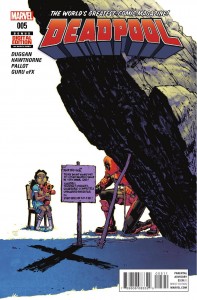 Parker’s defining quality is his obsessive morality (“With great power…,” and all that), while Wade, on his best day, is, maybe, chaotic good; the resulting byplay between them is a lot of fun. Kelly and McGuinness, who were the initial creative team on the very first Deadpool run back in the ’90s, are an inspired choice, and they deliver an entertaining, if sometimes scatological, first issue, one that Dpool-fans should appreciate (at no extra cost, the book also includes a full reprint of the recent Vision #1. That’s been an unexpectedly dark, quirky and well-crafted comic, one that a lot of readers presumably skipped, so kudos to Marvel for giving it a wider audience, one that will hopefully boost its sales). Meanwhile, the regular Deadpool book also shipped this week, and it also has an experienced writer, with Duggan having, by now, spent a couple of years chronicling the character’s adventures: in this new volume, he’s dealing with fame, being an Avenger, trying to
Parker’s defining quality is his obsessive morality (“With great power…,” and all that), while Wade, on his best day, is, maybe, chaotic good; the resulting byplay between them is a lot of fun. Kelly and McGuinness, who were the initial creative team on the very first Deadpool run back in the ’90s, are an inspired choice, and they deliver an entertaining, if sometimes scatological, first issue, one that Dpool-fans should appreciate (at no extra cost, the book also includes a full reprint of the recent Vision #1. That’s been an unexpectedly dark, quirky and well-crafted comic, one that a lot of readers presumably skipped, so kudos to Marvel for giving it a wider audience, one that will hopefully boost its sales). Meanwhile, the regular Deadpool book also shipped this week, and it also has an experienced writer, with Duggan having, by now, spent a couple of years chronicling the character’s adventures: in this new volume, he’s dealing with fame, being an Avenger, trying to  franchise his identity, and fighting with a new/old enemy, one with a better healing factor and an even more insane worldview; those provide enough soap-opera elements to keep readers coming back, too. Finally, there’s True Believers, a new best-of title that, in its debut issue, is reprinting Deadpool’s very first appearance, from New Mutants #98. That’s an issue that’s almost never been reprinted in single comic form, and is currently listed at $150 in NM in the price guide (and going for double that on eBay as the movie approaches), so the $1 cover price definitely makes it worth getting, if only to see Rob Liefeld’s combination of youthful energy and weird-ass human anatomy.
franchise his identity, and fighting with a new/old enemy, one with a better healing factor and an even more insane worldview; those provide enough soap-opera elements to keep readers coming back, too. Finally, there’s True Believers, a new best-of title that, in its debut issue, is reprinting Deadpool’s very first appearance, from New Mutants #98. That’s an issue that’s almost never been reprinted in single comic form, and is currently listed at $150 in NM in the price guide (and going for double that on eBay as the movie approaches), so the $1 cover price definitely makes it worth getting, if only to see Rob Liefeld’s combination of youthful energy and weird-ass human anatomy.
 Uncanny X-Men #1 — Writer: Cullen Bunn; Pencils: Greg Land; Inks: Jay Leisten; Colors: Nolan Woodard
Uncanny X-Men #1 — Writer: Cullen Bunn; Pencils: Greg Land; Inks: Jay Leisten; Colors: Nolan Woodard
A-Force #1 — Writer: G. Willow Wilson; Art: Jorge Molina; Colors: Laura Martin
A couple of Marvel first issues: Uncanny X-Men is a lot like the X-Force of a couple of years ago, with a squad of the more amoral mutants, led by Magneto, who want to take proactive measures against threats to their race and, while they won’t kill unnecessarily, don’t mind using terminal force if it’s required. The team consists of Sabertooth (who’s still feeling the effects of having his polarity reversed in the Axis mini-series, and so is considerably less murderous than he used to be), Monet from X-Factor, Psylocke, and a practically-mindless Archangel. This first issue is mostly an excuse to introduce the members and show what they can do, while filling readers in on the terrigen mists, etc., and it does that well enough, although the ending is predictably depressing. Greg Land’s very-polished art isn’t that good at panel-to-panel movement, but his people always look gorgeous, and he can deliver staged superhero poses with the best of them; the splash pages here, especially a double-page center-spread shot of the whole group, should make most readers happy. A-Force, the other debut, comes with a lot of anticipation as an all-women Avengers book done right, and written by, you know, an actual woman: Wilson, whose collected first volume of Ms. Marvel won a Hugo award for best graphic story last year, beating out both Matt Fraction and Brian K. Vaughan. This issue begins where the Secret Wars: A-Force mini-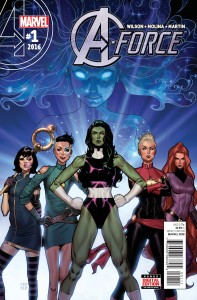 series left off: with Singularity, who’s some kind of sentient black hole, popping into the “new” Marvel universe and seeking out her friends — Captain Marvel, She-Hulk, Medusa, Dazzler and Nico from Runaways — only to find that they have no memory of their time on Battleworld, or of her; plus, some kind of antimatter being has followed her to earth, which leads to lots of running around and punching from all concerned. Between that conflict, the character introductions, and the background explanations, the issue is over quickly, but there’s more than enough to suggest that it can build into a lively and good-looking series, one with a tone and sensibility that will let it stand out from its competition.
series left off: with Singularity, who’s some kind of sentient black hole, popping into the “new” Marvel universe and seeking out her friends — Captain Marvel, She-Hulk, Medusa, Dazzler and Nico from Runaways — only to find that they have no memory of their time on Battleworld, or of her; plus, some kind of antimatter being has followed her to earth, which leads to lots of running around and punching from all concerned. Between that conflict, the character introductions, and the background explanations, the issue is over quickly, but there’s more than enough to suggest that it can build into a lively and good-looking series, one with a tone and sensibility that will let it stand out from its competition.
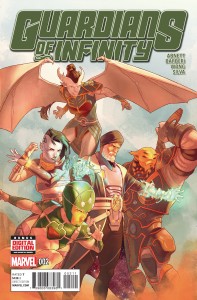 Guardians of Infinity #2 — Writer: Dan Abnett; Pencils: Carlo Barberi; Inks: Walden Wong; Colors: Israel Silva (second story) — Writer: Robbie Thompson; Pencils: Jim Cheung; Inks: Walden Wong and Guillermo Ortego; Colors: Matthew Wilson
Guardians of Infinity #2 — Writer: Dan Abnett; Pencils: Carlo Barberi; Inks: Walden Wong; Colors: Israel Silva (second story) — Writer: Robbie Thompson; Pencils: Jim Cheung; Inks: Walden Wong and Guillermo Ortego; Colors: Matthew Wilson
Totally Awesome Hulk #2 — Writer: Greg Pak; Art: Frank Cho; Colors: Sonia Oback
Weirdworld #2 — Writer: Sam Humphries; Art: Mike del Mundo; Colors: Mike del Mundo with Marco D’Alfonso
Three sophomore efforts — Guardians of Infinity is yet another GOTG comic, but worth a look because (a) it’s by Abnett, who co-wrote the ’00s Guardians adventures that pulled together the current team and caused the Disney people to decide that there might be a movie in there somewhere, and (b) because it’s set on a huge space structure that apparently has access to different 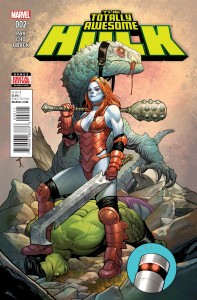 times and dimensions, allowing the current Guardians to mix with the original year-3000 versions, plus yet another incarnation of the team from circa 1,000 AD, all against a bunch of enormously-powerful high-tech foes. The back-up piece is a 15-page Drax/Rocket/Space Knights tale that manages to tell a complete, affective story in that limited space, something of a neglected art in a lot of modern serial comics. Totally Awesome Hulk is revealing itself, two issues in, as not as big a departure as one might think — Pak’s been doing high-quality Hulk stories for over a decade, and this is just a continuation of those, albeit with Banner only visible so far in flashbacks, and another member of the cast –a logical one, Amadeus Cho, the teen genius –undergoing the gamma-ray-fueled transformation. Having the artist’s name be the same as the now-main character’s is kind of weird, but otherwise Frank Cho is a good choice for the material;
times and dimensions, allowing the current Guardians to mix with the original year-3000 versions, plus yet another incarnation of the team from circa 1,000 AD, all against a bunch of enormously-powerful high-tech foes. The back-up piece is a 15-page Drax/Rocket/Space Knights tale that manages to tell a complete, affective story in that limited space, something of a neglected art in a lot of modern serial comics. Totally Awesome Hulk is revealing itself, two issues in, as not as big a departure as one might think — Pak’s been doing high-quality Hulk stories for over a decade, and this is just a continuation of those, albeit with Banner only visible so far in flashbacks, and another member of the cast –a logical one, Amadeus Cho, the teen genius –undergoing the gamma-ray-fueled transformation. Having the artist’s name be the same as the now-main character’s is kind of weird, but otherwise Frank Cho is a good choice for the material; 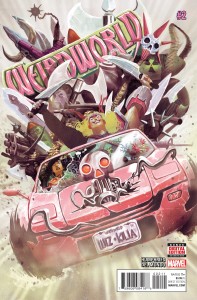 Pak, knowing his affinity for body-builder-type women, gives him both She-Hulk and a new butt-kicking monster hunter to draw. This book reminds me of Superior Spider-Man in the way it takes a potentially-disastrous idea and makes it work much better than pessimistic readers might have feared. Weirdworld, meanwhile, is a lot like its first issue — it follows its teen protagonist, marooned on the weird barbarian dimension (or planet, or whatever it is) of the title, and now a squire to a wizard-killing warrior woman named Galeta, and if you like barbarian-fantasy tales with an effective painterly style, some cool psychedelic coloring and a couple of nice-looking monster-slaying splash pages, then here you go.
Pak, knowing his affinity for body-builder-type women, gives him both She-Hulk and a new butt-kicking monster hunter to draw. This book reminds me of Superior Spider-Man in the way it takes a potentially-disastrous idea and makes it work much better than pessimistic readers might have feared. Weirdworld, meanwhile, is a lot like its first issue — it follows its teen protagonist, marooned on the weird barbarian dimension (or planet, or whatever it is) of the title, and now a squire to a wizard-killing warrior woman named Galeta, and if you like barbarian-fantasy tales with an effective painterly style, some cool psychedelic coloring and a couple of nice-looking monster-slaying splash pages, then here you go.
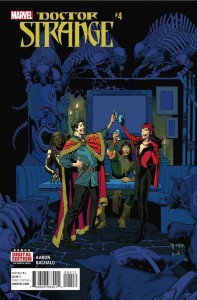 Doctor Strange #4 — Writer: Jason Aaron; Pencils/Colors: Chris Bachalo; Inks: seven people whose names I’m not going to type
Doctor Strange #4 — Writer: Jason Aaron; Pencils/Colors: Chris Bachalo; Inks: seven people whose names I’m not going to type
Invincible Iron Man #4 — Writer: Brian Michael Bendis; Art: David Marquez; Colors: Justin Ponsor
The Ultimates #3 — Writer: Al Ewing; Art: Kenneth Rocafort; Colors: Dan Brown
The Vision #3 — Writer: Tom King; Art: Gabrial  Hernandez Walta; Colors: Jordie Bellaire
Hernandez Walta; Colors: Jordie Bellaire
Some other Marvel offerings: Doctor Strange continues to be the best, on the strength of Bachalo’s art, while Aaron’s story in this issue involves Doc gathering a bunch of the other Marvel magic users to warn them of the coming storm; thus, we get to see Bachalo’s version of most of the other occult heavy hitters, plus action as our hero begins his battle with the big bad guys. Invincible Iron Man, meanwhile, wraps up its first arc, with Madame Masque 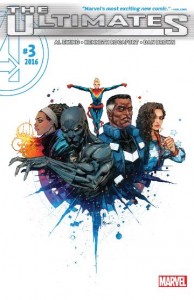 possessed, Dr. Doom doing the unexpected, and Mary Jane Watson signing on as a member of the supporting cast. Typically smooth script from Bendis, and Marquez delivers clear action and good-looking people to go with it. The Ultimates wants to be Marvel’s newest big-idea cosmic book, with two brainy super-science characters in Black Panther and Blue Marvel, plus space-worthy powerhouses like Spectrum and Captain Marvel, and the dimension-spanning powers of Ms. America. Put them together, and in just two issues they’ve already switched Galactus from an energy consumer to a
possessed, Dr. Doom doing the unexpected, and Mary Jane Watson signing on as a member of the supporting cast. Typically smooth script from Bendis, and Marquez delivers clear action and good-looking people to go with it. The Ultimates wants to be Marvel’s newest big-idea cosmic book, with two brainy super-science characters in Black Panther and Blue Marvel, plus space-worthy powerhouses like Spectrum and Captain Marvel, and the dimension-spanning powers of Ms. America. Put them together, and in just two issues they’ve already switched Galactus from an energy consumer to a  producer, one who can regrow planets instead of sucking them dry; in this newest installment, they’re tackling the broken Marvel timestream by traveling completely outside of everything: past the “superflow” (the interdimensional glue that DC calls “the bleed”), and past the “neutral zone,” the furthest edge of reality. This is all bright, shiny high-concept fun, well-told and well-drawn, so let’s hope this book finds the audience it deserves. So too for The Vision, a comic I’ve already praised this week (up in the Spider-Man/Deadpool #1 review); if you’ve read the first issue there, then pick up last month’s #2 and this new one, and you’ll be caught up on King and Walta’s quietly-creepy suburban-robot mystery.
producer, one who can regrow planets instead of sucking them dry; in this newest installment, they’re tackling the broken Marvel timestream by traveling completely outside of everything: past the “superflow” (the interdimensional glue that DC calls “the bleed”), and past the “neutral zone,” the furthest edge of reality. This is all bright, shiny high-concept fun, well-told and well-drawn, so let’s hope this book finds the audience it deserves. So too for The Vision, a comic I’ve already praised this week (up in the Spider-Man/Deadpool #1 review); if you’ve read the first issue there, then pick up last month’s #2 and this new one, and you’ll be caught up on King and Walta’s quietly-creepy suburban-robot mystery.
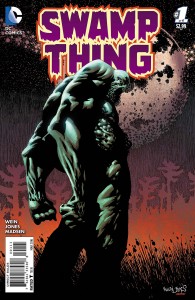 Swamp Thing #1 (of 6) — Writer: Len Wein; Art: Kelley Jones; Colors: Michelle Madsen
Swamp Thing #1 (of 6) — Writer: Len Wein; Art: Kelley Jones; Colors: Michelle Madsen
Action Comics #48 — Writer: Greg Pak; Pencils: Aaron Kuder and Rafa Sandoval; Inks: Aaron Kuder and Jordi Tarragona; Colors: Tomeu Morey
Only two DCs this time: Swamp Thing is a mini-series by the character’s creator, Len Wein; it’s not drawn by original artist Berni Wrightson, but Kelley Jones has an uncannily similar style, so this looks, and feels, much like the original ’70s incarnation, as the former Alex Holland encounters, variously, a cranky alligator, the Phantom Stranger, and an 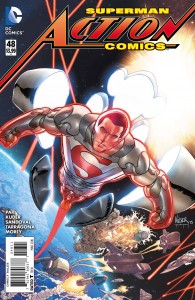 extremely strong and revenge-obsessed animated corpse. The result is a stylish horror story, one that should be attractive to both older and newer readers. Over in Action, meanwhile, the depowered-Superman story that’s been going on for six months is moving into its endgame, as the behind-the-scenes villain has been revealed, and Clark Kent, still only a shadow of his former super-self, has to fight him with most of the Justice League out of commission; this has probably gone on a bit too long, but it’s been a fascinating look at what makes Kent a hero, and as long as they don’t spin it out another six months it should end up as one of the better Superman sequences of this century, at least.
extremely strong and revenge-obsessed animated corpse. The result is a stylish horror story, one that should be attractive to both older and newer readers. Over in Action, meanwhile, the depowered-Superman story that’s been going on for six months is moving into its endgame, as the behind-the-scenes villain has been revealed, and Clark Kent, still only a shadow of his former super-self, has to fight him with most of the Justice League out of commission; this has probably gone on a bit too long, but it’s been a fascinating look at what makes Kent a hero, and as long as they don’t spin it out another six months it should end up as one of the better Superman sequences of this century, at least.
 Four Eyes: Hearts of Fire #1 (of 4) — Writer: Joe Kelly; Art: Max Fiumara
Four Eyes: Hearts of Fire #1 (of 4) — Writer: Joe Kelly; Art: Max Fiumara
The Last Contract #1 (of 4) — Writer: Ed Brisson; Art: Lisandro Estherren; Colors: Niko Guardia
Lone Wolf 2100: Chase The Setting Sun #1 — Writer: Eric Heisserer; Art: Miguel Sepulveda; Colors: Javier Mena
Three indy debuts (although two involve characters we’ve seen before): Four Eyes is the second volume of Kelly and Fiumara’s tale of a Depression-era kid who wants to break out of poverty and learn how to train… well, in a regular story it’d be horses, or hunting dogs, but this is a fantasy, so 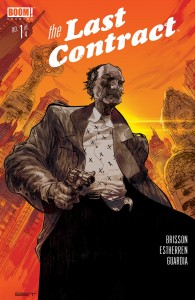 it’s dragons: elephant-sized lizards who are bred to fight for the public’s amusement. The kid, of course, has stumbled across a young specimen (the “Four Eyes” of the title) he keeps as a pet, but finds out that training such a creature is considerably more complicated, and cruel, than he thought. This is all done with Kelly’s typically-solid plotting, while Fiumara has a mostly-realistic but just-caricatured-enough style that nails the tenement realism while making the big lizards believable too. The Last Contract is about a former hitman, now old and starting to be forgetful, who’s targeted by assassins sent from his former boss, and ends up looking for revenge. If this sounds like Warren Ellis’s Red, only with hitmen instead of CIA assassins… yeah, it’s pretty
it’s dragons: elephant-sized lizards who are bred to fight for the public’s amusement. The kid, of course, has stumbled across a young specimen (the “Four Eyes” of the title) he keeps as a pet, but finds out that training such a creature is considerably more complicated, and cruel, than he thought. This is all done with Kelly’s typically-solid plotting, while Fiumara has a mostly-realistic but just-caricatured-enough style that nails the tenement realism while making the big lizards believable too. The Last Contract is about a former hitman, now old and starting to be forgetful, who’s targeted by assassins sent from his former boss, and ends up looking for revenge. If this sounds like Warren Ellis’s Red, only with hitmen instead of CIA assassins… yeah, it’s pretty  much the same story, with Estherren doing a reasonably-good job of delineating the various mobsters, bikers and other lowlifes that the lead character encounters and, mostly, dispatches bloodily; if you like crime books, this isn’t a bad one. Lone Wolf 2100 is a sequel to Dark Horse’s early-’00s attempt to transplant Lone Wolf and Cub from feudal Japan to the future, with a robot with a sword guarding a little girl during a sort-of zombie apocalypse; it’s OK if you like that sort of thing, but the actual Lone Wolf and Cub books are one of the high points of 20th-century comics storytelling, at least ten times better than this stuff, so you’d be better off spending your money on them instead.
much the same story, with Estherren doing a reasonably-good job of delineating the various mobsters, bikers and other lowlifes that the lead character encounters and, mostly, dispatches bloodily; if you like crime books, this isn’t a bad one. Lone Wolf 2100 is a sequel to Dark Horse’s early-’00s attempt to transplant Lone Wolf and Cub from feudal Japan to the future, with a robot with a sword guarding a little girl during a sort-of zombie apocalypse; it’s OK if you like that sort of thing, but the actual Lone Wolf and Cub books are one of the high points of 20th-century comics storytelling, at least ten times better than this stuff, so you’d be better off spending your money on them instead.
 Paper Girls #4 — Writer: Brian K. Vaughan; Art: Cliff Chiang; Colors: Matt Wilson
Paper Girls #4 — Writer: Brian K. Vaughan; Art: Cliff Chiang; Colors: Matt Wilson
Archie #5 — Writer: Mark Waid; Art: Veronica Fish; Colors: Andre Szymanowicz with Jen Vaughn
Bitch Planet #6 — Writer: Kelly Sue DeConnick; Art: Taki Soma; Colors: Kelly Fitzpatrick
The Fade Out #12 (of 12) — Writer: Ed Brubaker; Art: Sean Phillips; Colors: Elizabeth Breitweiser
 The other cool indy stuff: Paper Girls is Brian K. Vaughan’s Spielbergian suburban sf adventure, with the title characters a scrappy quartet caught in the middle of a time-travelling future battle between kids and adults… or something (four issues in, the plot is still being revealed, and Vaughan has a history of jaw-dropping twists, so it’s not all exactly clear yet). Archie continues its more-modern reboot, with Mark Waid doing a smart job of updating and re-dramatizing the characters and their relationships (Veronica has just moved into town), while keeping their essential personalities, and the book’s signature slapstick
The other cool indy stuff: Paper Girls is Brian K. Vaughan’s Spielbergian suburban sf adventure, with the title characters a scrappy quartet caught in the middle of a time-travelling future battle between kids and adults… or something (four issues in, the plot is still being revealed, and Vaughan has a history of jaw-dropping twists, so it’s not all exactly clear yet). Archie continues its more-modern reboot, with Mark Waid doing a smart job of updating and re-dramatizing the characters and their relationships (Veronica has just moved into town), while keeping their essential personalities, and the book’s signature slapstick 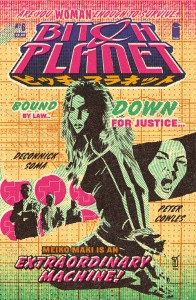 humor, in place; Veronica Fish isn’t Fiona Staples (no one, of course, is), but she does a good job at navigating the sweet spot between the serious and funny elements, and making us believe in Riverdale’s little pocket of reality. Bitch Planet also accomplishes a balancing act, but here it’s between the exploitation films that are its starting point (it’s a mashup of sf, dystopian and women-in-prison movies) with a very modern, and very thought-out, feminist philosophy, one that’s resonated with a number of readers and already made the book into a cult favorite. Here, the creative team explores the backstory of one of
humor, in place; Veronica Fish isn’t Fiona Staples (no one, of course, is), but she does a good job at navigating the sweet spot between the serious and funny elements, and making us believe in Riverdale’s little pocket of reality. Bitch Planet also accomplishes a balancing act, but here it’s between the exploitation films that are its starting point (it’s a mashup of sf, dystopian and women-in-prison movies) with a very modern, and very thought-out, feminist philosophy, one that’s resonated with a number of readers and already made the book into a cult favorite. Here, the creative team explores the backstory of one of  their characters, Meiko, and we get a clearer picture of the male-dominated future-society setting; the issue also works as a good one-issue sampler for new readers of the book’s many charms — although they’ll have to come back next issue, when all the other characters are on display, to get the full effect. That leaves The Fade Out, which is, in fact, fading to black with this concluding issue, its tale of post-war Hollywood corruption and murder giving up its secrets in typical noir fashion. Its two trade collections should give Brubaker and Phillips a total of seventeen in print (Scene of the Crime, Incognito, and a bunch of Criminal and Fatale volumes), an impressive body of hard-boiled crime work.
their characters, Meiko, and we get a clearer picture of the male-dominated future-society setting; the issue also works as a good one-issue sampler for new readers of the book’s many charms — although they’ll have to come back next issue, when all the other characters are on display, to get the full effect. That leaves The Fade Out, which is, in fact, fading to black with this concluding issue, its tale of post-war Hollywood corruption and murder giving up its secrets in typical noir fashion. Its two trade collections should give Brubaker and Phillips a total of seventeen in print (Scene of the Crime, Incognito, and a bunch of Criminal and Fatale volumes), an impressive body of hard-boiled crime work.



